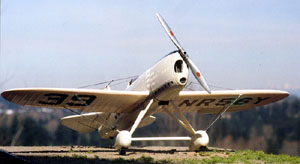Hawk/Testors 1/48 Howard DGA-5 "Ike" | | History Benjamin Odell Howard - Benny Howard - was born February 9, 1904 in Palestine, Texas a small farming town about 100 miles southeast of Fort Worth. He dropped out of high school in his second year to help support the family by working as a roustabout in the oil fields. The work was hard and dull but the pay was very good. A barnstorming group of flyers passing through the area aroused the 17-year-old Benny's interest in aviation. He left the oil fields to work in Houston as a mechanic and soon saved enough money to buy a used Standard biplane, which he set about teaching himself to fly. He crashed the Standard, writing it off, killing his paying passenger and messing up a leg so that he limped for the rest of his life. After recuperating he designed and built his first airplane, a two-place side-by-side, OX-5 powered biplane; retrospectively, the DGA-1. To make enough money to support his flying habit Benny went to work for some Texas Bootleggers flying booze from New Orleans to various Texas destinations in their Hisso powered Lincoln Standard. Benny modified the plane beyond recognition by enlarging the wings and deepening the fuselage for greater lift and carrying capacity; retrospectively, the DGA-2. Whilst flying and maintaining this "15 Case Special" for a living Benny sold the DGA-1.  In 1928, seeking job stability and security he joined Robertson Airlines of St. Louis as a line pilot. Through a series of mergers and acquisitions Robertson disappeared into what became United Airlines and Benny stayed with them through it all. In 1928, seeking job stability and security he joined Robertson Airlines of St. Louis as a line pilot. Through a series of mergers and acquisitions Robertson disappeared into what became United Airlines and Benny stayed with them through it all.
In 1929 seeking relief from the monotony of line flying, Benny decided to build himself a small inexpensive racer. Knowing he lacked expertise in the theory and application of the sciences of aerodynamics and structures he teamed with Gordon Israel, a student at Parks Air College to help him out. They became life long friends and aviation associates. The product of their collaboration was the Howard DGA-3 "Pete" a very pretty little white racer. Benny's sense of humor and irreverence led him to pick "DGA" as the model prefix for his airplanes after one of his bootlegger employers had referred to the "15 Case Special" as a "Damned Good Airplane". 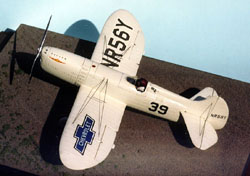 Pete was incredibly successful and led, in 1932, to DGA-4 "Mike" an airplane very similar to Pete, but with a 200HP Menasco Buccaneer inverted, air-cooled, six-cylinder engine instead of Pete's 95HP upright, air cooled four cylinder Wright-Gypsy (license built from DeHavilland). Mike was quickly followed by the, essentially, identical DGA-5 "Ike". In August of 1932 Benny took his three little white racers to Cleveland for the National Air Races and with Bill Ong and Gladys O'Donnell helping with the flying, scored three 1sts, three 2nds, a 4th, two 5ths, a 7th and an 8th.cleaning up on prize money. After the '32 racing season UAL prohibited their pilots from participating in closed course racing, so Benny recruited others to fly the pylon races for him. Pete was incredibly successful and led, in 1932, to DGA-4 "Mike" an airplane very similar to Pete, but with a 200HP Menasco Buccaneer inverted, air-cooled, six-cylinder engine instead of Pete's 95HP upright, air cooled four cylinder Wright-Gypsy (license built from DeHavilland). Mike was quickly followed by the, essentially, identical DGA-5 "Ike". In August of 1932 Benny took his three little white racers to Cleveland for the National Air Races and with Bill Ong and Gladys O'Donnell helping with the flying, scored three 1sts, three 2nds, a 4th, two 5ths, a 7th and an 8th.cleaning up on prize money. After the '32 racing season UAL prohibited their pilots from participating in closed course racing, so Benny recruited others to fly the pylon races for him.
Ike originally had an awkward pair of tandem wheel bogies in long skinny wheel pants to reduce drag. This proved to be more trouble than it was worth and Ike was given a conventional, for the time, unsprung undercarriage. All three racers went through a long series of minor modifications and detail paint changes. So, if you're going to model one of these little birds you need to be careful to pick a particular photo and build to it. 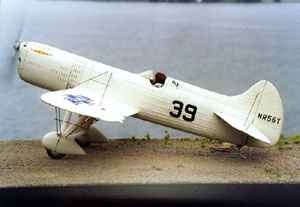 In 1934 Benny designed his best-known racer, the DGA-6 "Mr. Mulligan". Mr. Mulligan missed the 1934 race season as it was heavily damaged in a forced landing whilst being ferried to California for the start of the Bendix cross-country race. The next year, 1935, with Benny flying and Gordon Israel as co-pilot, Mr. Mulligan won the Van Nuys to Cleveland race by less than a minute over Roscoe Turner's big Wasp-Major powered Wedell-Williams "MacMillan Special". Benny then entered Mr. Mulligan in the Thompson Trophy closed course race, the premier event of the National Air Races, with Harold Neumann flying. A delayed start caused most entrants' engines to overheat, leading to an early failure of Roscoe Turners Wasp, putting him out of the race. Although restricted to only about 80% of full power, due to damage to his own overheated engine, Neumann manage to stay ahead of Steve Wittman's Curtiss D-12 powered "Bonzo". Mr. Mulligan is the only airplane to win both the Bendix and Thompson races. One of these years I've got to build a decent model of Mr. Mulligan. The original Mr. Mulligan was destroyed in the 1936 Bendix with Benny flying and his wife, Maxine, as co-pilot when the Smith controllable pitch propeller threw a blade causing a forced landing that turned out to be more of a crash. Both Benny and Maxine were trapped for many hours in the wreckage before being rescued. Benny lost a foot, exacerbating his limp, and one of Maxine's legs was injured giving her a permanent limp to match Benny's. In 1934 Benny designed his best-known racer, the DGA-6 "Mr. Mulligan". Mr. Mulligan missed the 1934 race season as it was heavily damaged in a forced landing whilst being ferried to California for the start of the Bendix cross-country race. The next year, 1935, with Benny flying and Gordon Israel as co-pilot, Mr. Mulligan won the Van Nuys to Cleveland race by less than a minute over Roscoe Turner's big Wasp-Major powered Wedell-Williams "MacMillan Special". Benny then entered Mr. Mulligan in the Thompson Trophy closed course race, the premier event of the National Air Races, with Harold Neumann flying. A delayed start caused most entrants' engines to overheat, leading to an early failure of Roscoe Turners Wasp, putting him out of the race. Although restricted to only about 80% of full power, due to damage to his own overheated engine, Neumann manage to stay ahead of Steve Wittman's Curtiss D-12 powered "Bonzo". Mr. Mulligan is the only airplane to win both the Bendix and Thompson races. One of these years I've got to build a decent model of Mr. Mulligan. The original Mr. Mulligan was destroyed in the 1936 Bendix with Benny flying and his wife, Maxine, as co-pilot when the Smith controllable pitch propeller threw a blade causing a forced landing that turned out to be more of a crash. Both Benny and Maxine were trapped for many hours in the wreckage before being rescued. Benny lost a foot, exacerbating his limp, and one of Maxine's legs was injured giving her a permanent limp to match Benny's.
Giving up racing Benny went on to found the Howard Aircraft Company in January 1937 to design and build a series of fast, comfortable, four place touring airplanes - DGA-8 through DGA-15 - that are much sought after today as very desirable classics. Benny continued to fly with United as a test pilot until he retired. The Model One fine day in early September 1948 when I went into my flight instructor's office at the Jasper, Indiana airport, I was stunned to see a beautiful little model of Benny Howard's DGA-5 Ike racer. Bob Ashley had simply glued it together out-of-the-Hawk box; no paint, no decals, no filler - just glued it together. Compared to my solid wood models it was amazingly beautiful. "Where did you get it?" I asked.  "At ABC Hobbies in Evansville yesterday. They had some others too." "At ABC Hobbies in Evansville yesterday. They had some others too."
"What did it cost?" "Two bits", he said. "You want to go get a couple for yourself?" "Sure. When? How?" He thought for a moment, "How about a practice cross country sometime this week?" "Sure." We made that 60-mile flight and I built my Ike as Bob had his; I just glued it together. It would be over 20 years before I finally built the fairly decent model of Ike shown here. I suppose I should now build a pretty good Mike as a companion to Ike. 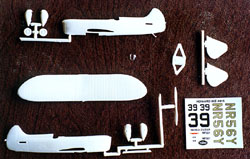 The Build The Build
The model in the photos was intended to be a "throw-away, quickie". I wanted a simple model finished quickly to just get one done without spending eons of time on it. This approach NEVER works. The "simple" model picked to be finished quickly always turns out not to be "simple". Never fails. First off this wee slinket beastie has inscribed lines representing the fuselage stringers and wing rib tapes. Damn! I cut a lot of Scotch tape into .020" strips to be burnished over/into those inscribed lines to simulate stringers and rib tapes after heavy painting. The two intakes in the nose were opened up. A length of machine screw serves as the number one cylinder with a chrome pushrod tube from a straight pin. A close-to-scale thickness windscreen was vac-formed over the kit piece. A Monogram 1/48th scale Mustang pilot was painted to represent Benny Howard to fill the cockpit opening and hide the fact there is no detail in there at all. Hirsch drawings were used as a guide for all the general configuration, details, and markings work. The Chevrolet insignia is a composite decal made of black Pres-Type letters, and plain white, plain black and plain blue Micro-Scale colored stock. The balance of the markings are from the kit decals. One big error was my application of hand painted Hamilton-Standard logos on the Smith propeller! Oh well, there's no accounting for ignorance and insufficient research is there? Don't you do it! Rigging is monofilament nylon. The paint is Testors gloss white applied with an old Magna-Flux dye-penetrant sprayer. The kit's nose intake contours are a bit off and the wheel pants are too large, otherwise it is accurate enough. On the model shown, I did not correct either of these faults. A model of Mike could easily be built from this kit with, mostly, just a change of markings. Pete could also be built from this kit by making a new fuselage to mate with Ike's wings and empennage. 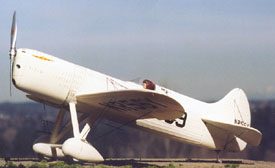 Conclusion Conclusion
The Hawk racers were among the first plastic kits offered in the US over 50 years ago and they're still being issued by Testors. As I recall, the original series included: Gee-Bee R-2, Howard DGA-5 Ike, Curtiss R3C-1, Supermarine S.6B, Laird Solution, Travel Aire Mystery Ship and Curtiss R3C-2. The Mystery Ship is on a par with many current offerings. References -
IPMS/USA QUARTERLY , 2Q7 & 2Q8: drawings by Hirsch. -
HISTORICAL AVIATION ALBUM, Vols. XII, XIII & XIV: Paul R. Matt, in-depth article, photos and great drawings of Pete, Mike, Ike and Mr. Mulligan. -
AMERICAN AIRCRAFT MODELER, September 1968: Paul R. Matt article, photos and drawings of Howard DGA-15. | 


 



  
    |
 In 1928, seeking job stability and security he joined Robertson Airlines of St. Louis as a line pilot. Through a series of mergers and acquisitions Robertson disappeared into what became United Airlines and Benny stayed with them through it all.
In 1928, seeking job stability and security he joined Robertson Airlines of St. Louis as a line pilot. Through a series of mergers and acquisitions Robertson disappeared into what became United Airlines and Benny stayed with them through it all. Pete was incredibly successful and led, in 1932, to DGA-4 "Mike" an airplane very similar to Pete, but with a 200HP Menasco Buccaneer inverted, air-cooled, six-cylinder engine instead of Pete's 95HP upright, air cooled four cylinder Wright-Gypsy (license built from DeHavilland). Mike was quickly followed by the, essentially, identical DGA-5 "Ike". In August of 1932 Benny took his three little white racers to Cleveland for the National Air Races and with Bill Ong and Gladys O'Donnell helping with the flying, scored three 1sts, three 2nds, a 4th, two 5ths, a 7th and an 8th.cleaning up on prize money. After the '32 racing season UAL prohibited their pilots from participating in closed course racing, so Benny recruited others to fly the pylon races for him.
Pete was incredibly successful and led, in 1932, to DGA-4 "Mike" an airplane very similar to Pete, but with a 200HP Menasco Buccaneer inverted, air-cooled, six-cylinder engine instead of Pete's 95HP upright, air cooled four cylinder Wright-Gypsy (license built from DeHavilland). Mike was quickly followed by the, essentially, identical DGA-5 "Ike". In August of 1932 Benny took his three little white racers to Cleveland for the National Air Races and with Bill Ong and Gladys O'Donnell helping with the flying, scored three 1sts, three 2nds, a 4th, two 5ths, a 7th and an 8th.cleaning up on prize money. After the '32 racing season UAL prohibited their pilots from participating in closed course racing, so Benny recruited others to fly the pylon races for him. In 1934 Benny designed his best-known racer, the DGA-6 "Mr. Mulligan". Mr. Mulligan missed the 1934 race season as it was heavily damaged in a forced landing whilst being ferried to California for the start of the Bendix cross-country race. The next year, 1935, with Benny flying and Gordon Israel as co-pilot, Mr. Mulligan won the Van Nuys to Cleveland race by less than a minute over Roscoe Turner's big Wasp-Major powered Wedell-Williams "MacMillan Special". Benny then entered Mr. Mulligan in the Thompson Trophy closed course race, the premier event of the National Air Races, with Harold Neumann flying. A delayed start caused most entrants' engines to overheat, leading to an early failure of Roscoe Turners Wasp, putting him out of the race. Although restricted to only about 80% of full power, due to damage to his own overheated engine, Neumann manage to stay ahead of Steve Wittman's Curtiss D-12 powered "Bonzo". Mr. Mulligan is the only airplane to win both the Bendix and Thompson races. One of these years I've got to build a decent model of Mr. Mulligan. The original Mr. Mulligan was destroyed in the 1936 Bendix with Benny flying and his wife, Maxine, as co-pilot when the Smith controllable pitch propeller threw a blade causing a forced landing that turned out to be more of a crash. Both Benny and Maxine were trapped for many hours in the wreckage before being rescued. Benny lost a foot, exacerbating his limp, and one of Maxine's legs was injured giving her a permanent limp to match Benny's.
In 1934 Benny designed his best-known racer, the DGA-6 "Mr. Mulligan". Mr. Mulligan missed the 1934 race season as it was heavily damaged in a forced landing whilst being ferried to California for the start of the Bendix cross-country race. The next year, 1935, with Benny flying and Gordon Israel as co-pilot, Mr. Mulligan won the Van Nuys to Cleveland race by less than a minute over Roscoe Turner's big Wasp-Major powered Wedell-Williams "MacMillan Special". Benny then entered Mr. Mulligan in the Thompson Trophy closed course race, the premier event of the National Air Races, with Harold Neumann flying. A delayed start caused most entrants' engines to overheat, leading to an early failure of Roscoe Turners Wasp, putting him out of the race. Although restricted to only about 80% of full power, due to damage to his own overheated engine, Neumann manage to stay ahead of Steve Wittman's Curtiss D-12 powered "Bonzo". Mr. Mulligan is the only airplane to win both the Bendix and Thompson races. One of these years I've got to build a decent model of Mr. Mulligan. The original Mr. Mulligan was destroyed in the 1936 Bendix with Benny flying and his wife, Maxine, as co-pilot when the Smith controllable pitch propeller threw a blade causing a forced landing that turned out to be more of a crash. Both Benny and Maxine were trapped for many hours in the wreckage before being rescued. Benny lost a foot, exacerbating his limp, and one of Maxine's legs was injured giving her a permanent limp to match Benny's.  "At ABC Hobbies in Evansville yesterday. They had some others too."
"At ABC Hobbies in Evansville yesterday. They had some others too."  The Build
The Build Conclusion
Conclusion